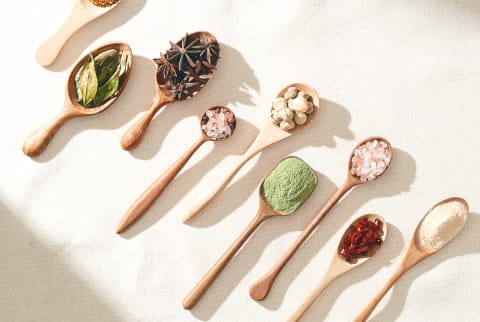Advertisement
Culinary Use Of Ginger, Turmeric & Cinnamon All Show Metabolic Health Benefits


A little bit of spice can go a long way—whether that's to add color, heighten the taste, or enrich the aroma of food.
And good news for spice lovers: A recent research review looked at 142 studies to determine how some of the most commonly consumed herbs and spices1 can improve our metabolic health. And results are particularly applicable because the studies included used culinary doses of these ingredients—aka the teaspoon here and tablespoon there that home cooks tend to use in the kitchen.
The next time you freshen up your spice cabinet, look to these spices that appeared to have the most blood-sugar-balancing and cholesterol-lowering benefits.
Ginger helps with inflammation & cardiometabolic health
Ginger is a flowering plant, but it's the root of the plant that is used for culinary and medicinal purposes. The benefits are thought to come from gingerol2, a bioactive compound with anti-inflammatory and antioxidant properties.
In this review, studies on ginger were found to have a positive effect on blood sugar, insulin, cholesterol, and triglycerides. In addition, four out of five studies that focused on inflammation revealed that ginger helped improve those markers.
These benefits were seen by consuming anywhere from 1.5 to 3 grams of ginger root daily. That's around 1 tablespoon of fresh grated or minced ginger or ¾ teaspoon powdered ginger (but you can always pull out your trusted kitchen scale to confirm).
Turmeric helps with blood lipids
Turmeric is an ancient Ayurvedic root that is actually a cousin to ginger. Turmeric has potent antioxidant properties thanks to compounds called curcuminoids. Curcumin is the most notable curcuminoid that has been scientifically studied3. Pure turmeric powder is about 3.14% curcumin by weight4.
Out of all the studies on culinary turmeric use and health outcomes, most looked at turmeric's impact on blood lipid levels such as triglycerides, total cholesterol, and LDL cholesterol. And yes, the spice can help lower undesirably high levels of these markers.
Three studies included in this review looked at the spice's impact on inflammatory markers, with two showing a significant benefit on inflammation levels. All these benefits were seen with consuming around 2.1 to 2.4 grams a day (between ½ and 1 teaspoon).
But the bioavailability (or the body's ability to uptake and use this compound) is unbelievably low5. While pairing turmeric with black pepper can help boost the bioavailability of curcumin, many turmeric supplements are formulated with optimal absorption in mind to ensure you get the most benefits. These are our favorite dietitian-vetted turmeric supplements (our fave one is even paired with ginger for additional antioxidant protection).
Turmeric supplements are better studied than the actual spice, especially when it comes to inflammation and joint health. So, if those are the main benefits you're looking for, consider a targeted supplement in addition to using turmeric in different curries, on chicken, or in scrambled eggs.
Cinnamon should be a go-to for blood sugar
This baking essential comes from the inner bark of Cinnamomum trees and has long been regarded for its healing properties thanks to an array of antioxidants.
Recent research on cinnamon has investigated its role in regulating blood sugar, specifically for those with diabetes. One way cinnamon may help lower blood sugar6 is by slowing the breakdown of carbohydrates in the digestive tract, in turn, slowing the amount of glucose7 that enters the bloodstream at once. Consuming between 1 and 6 grams (roughly one-half to 2 teaspoons) of cinnamon per day has been shown to lower fasting blood sugar levels8 by 10 to 29%.
The takeaway
You don't need heaps and heaps of spice to tastefully season a dish or to reap health benefits. Even one-half teaspoon of a spice each day can make a significant impact on your health, and that's pretty exciting. This new review is a great reminder to be creative in the kitchen because the end result will be not only delectable but also nutritious.
8 Sources
- https://www.mdpi.com/2072-6643/15/23/4867
- https://www.ncbi.nlm.nih.gov/pubmed/25230520
- https://www.ncbi.nlm.nih.gov/pmc/articles/PMC3535097/
- https://pubmed.ncbi.nlm.nih.gov/17044766/
- https://www.ncbi.nlm.nih.gov/pmc/articles/PMC6770259/
- https://www.ncbi.nlm.nih.gov/pubmed/21538147
- https://www.ncbi.nlm.nih.gov/pubmed/21711570
- https://www.ncbi.nlm.nih.gov/pubmed/19930003
Watch Next
Enjoy some of our favorite clips from classes
Enjoy some of our favorite clips from classes
What Is Meditation?
Mindfulness/Spirituality | Light Watkins
Box Breathing
Mindfulness/Spirituality | Gwen Dittmar
What Breathwork Can Address
Mindfulness/Spirituality | Gwen Dittmar
The 8 Limbs of Yoga - What is Asana?
Yoga | Caley Alyssa
Two Standing Postures to Open Up Tight Hips
Yoga | Caley Alyssa
How Plants Can Optimize Athletic Performance
Nutrition | Rich Roll
What to Eat Before a Workout
Nutrition | Rich Roll
How Ayurveda Helps Us Navigate Modern Life
Nutrition | Sahara Rose
Messages About Love & Relationships
Love & Relationships | Esther Perel
Love Languages
Love & Relationships | Esther Perel
What Is Meditation?
Box Breathing
What Breathwork Can Address
The 8 Limbs of Yoga - What is Asana?
Two Standing Postures to Open Up Tight Hips
How Plants Can Optimize Athletic Performance
What to Eat Before a Workout
How Ayurveda Helps Us Navigate Modern Life
Messages About Love & Relationships
Love Languages
Advertisement

This Gave Me Osteoporosis At 32 & Here's What I Wish People Knew
AmiCietta Duche Clarke

New Study Shows This Vitamin May Lower Your Risk Of Alzheimer’s By 17%
Molly Knudsen, M.S., RDN

This Gave Me Osteoporosis At 32 & Here's What I Wish People Knew
AmiCietta Duche Clarke

New Study Shows This Vitamin May Lower Your Risk Of Alzheimer’s By 17%
Molly Knudsen, M.S., RDN













